Last Updated on 09/19/2023 by Desmond
Most people heard about Oolong tea. Various Oolong blended tea products are sold in Starbucks and malls, the big brand like Lipton also offers Oolong tea bags. People take it for granted that Oolong tea should be blended for a better taste and ignore its original flavor is also charming. Not to mention, few people have ever seen or tasted Oolong loose leaf. The first time you see it, you might mistake it for black tea or green tea; they look very similar.
CONTENT
What Is Oolong Tea
Did you think I said something wrong? Black tea and green tea have totally different looks; how can Oolong tea look like them at the same time?
In China, teas will be classified into 6 types according to the processing method; and this taxonomy is globally recognized. Oolong tea is a separate category, also called partially-fermented tea. Oolong tea has various subtypes, and they got different fermentation degrees and processing. So some look like green tea, some like black tea, and some like dark tea. You may see, Oolong tea’s flavor varies significantly among different types; it is a rare situation in other tea types.
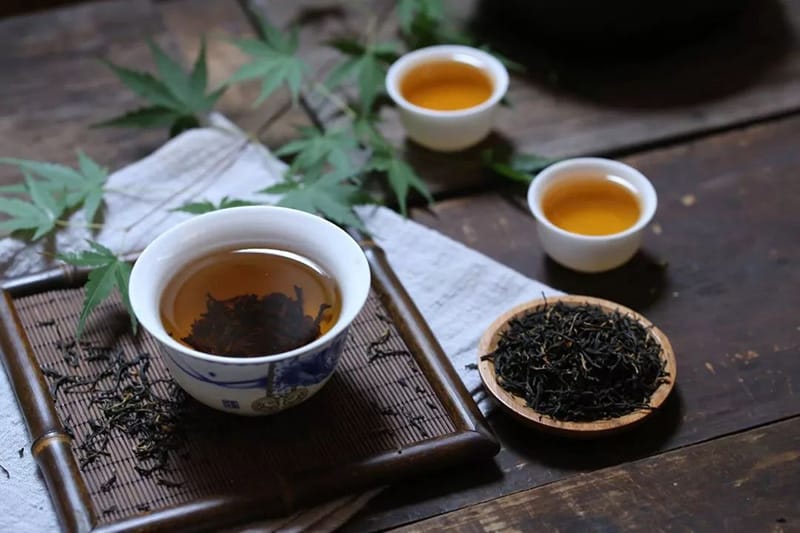
Names Legends
To know about one thing, we usually start from its name.
The Chinese meaning of Oolong is a huge dark dragon because its leaves are dark and curly. Another saying is, this name is from a tea master named Hu Liang; their names’ Chinese pronunciation is similar.
The most famous legend is that Oolong tea started from a funny story. A long time ago in Fujian, when a lazy tea master processing green tea, he placed the leaves on the ground casually, and the leaves were crushed.
The tea master didn’t notice it and went to sleep. After he woke up, the leaves turned dark and looked like a dragon; he was so scared. The others know the truth, laugh at him, said he took an “Oolong,” and these teas are “Oolong tea.” In the local language, Oolong means misunderstand, similar to the Own goal in soccer.
History
According to historical records, Oolong tea’s rudiment appeared in Song Dynasty(about 1000 years ago.) At that time, the Fujian tea industry had been very developed, and the Tuan Cha (a type of compressed green tea) was listed as a tribute for royal consumption. Due to the backward productivity, many leaves were broken and fermenting during processing. They could not be offered to the royal, only for tea masters consuming themselves.
Later, tea masters found that if the leaves were broken under some conditions, they could be processed into the unique flavor tea. After a long time of study and optimization, the Oolong tea processing method was finally invented.
According to the historical records, Oolong tea was invented by Anxi(Minnan) people in 1725. The flavor was fantastic, and the Minbei people also started to produce Oolong tea soon. Later, as a port city, Fujian also spread the Oolong tea trees, cultivation, and processing methods overseas, such as in Taiwan.
Oolong Tea Processing
Each Oolong tea’s processing is similar; some of them will repeat some steps times and a little different on the operation. Leaves after picking will be through withering, sunning, shaking, frying, rolling, and drying to process into rough teas. Among these, shaking is the most essential step in creating the Oolong tea unique flavor, which results from tea masters long time research.
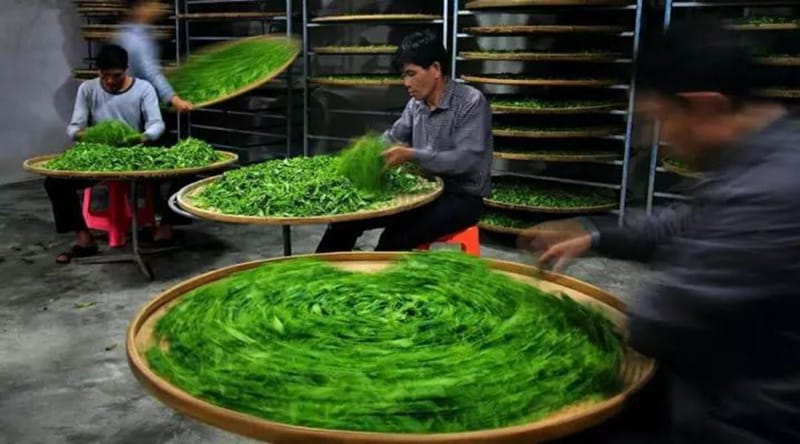
Shaking refers to tea masters putting the leaves in a giant bamboo sieve and keeping shaking it, making the leaves rub and crush each other. Thus, the rim part of the leaf will be broke, the juice flows out, covers the surface, and gets oxidation. After shaking, the leaves will be placed, the water flows back into the body through the vein, and making it soft again.
If you ever noticed the Oolong leaves after brewed, you will found that the rim is obviously red; it is the so-called “green leaf with a red rim.” Thus, Oolong tea is also called partially-fermented tea.
Due to the rub and oxidation, the leaves’ temperature rises during the process, leading to the dramatic transformation of internal substance. The flavor of every type of Oolong sets the basic at this moment. A senior tea master will decide the suitable shaking frequency and strength according to the leaves’ weight and smell etc.
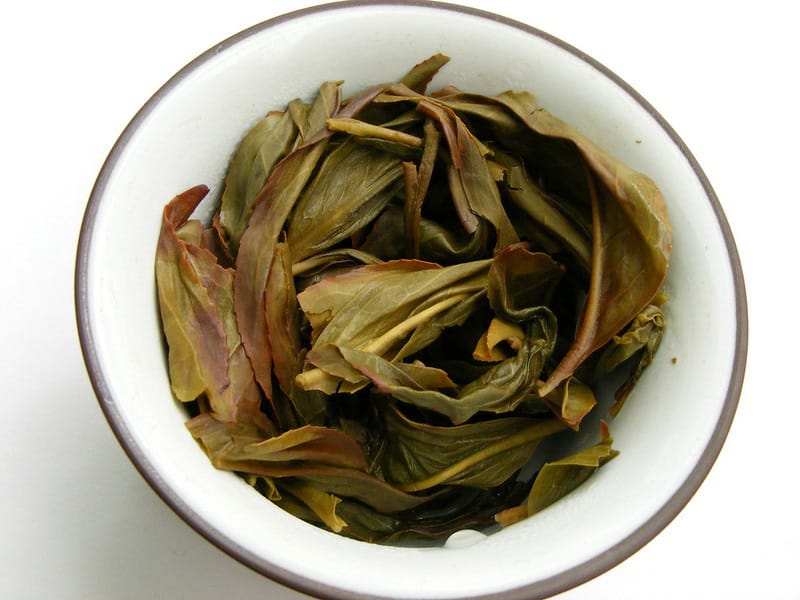
Primary Origins
According to different origins, Oolong teas are classified into several cliques. Although many places in the world produce Oolong tea, Fujian no doubt is the most authentic one and with the largest yield. There are hundreds of great tea trees; they are all suitable to produce excellent Oolong tea with different flavors. As a pillar industry, the local tea masters always keep working on study and cultivation to produce better teas.
Southern Fujian
Southern Fujian is also called Minnan, where the Oolong tea birthplace. Here grow 4 excellent tea trees: Tieguanyin, Huang Dan, Ben Shan, and Mao Xie. Tieguanyin may be the most famous, possibly the first Oolong that many people tried. Most Minnan Oolongs have a low fermentation degree, leaves still green, with a light infusion color. The aroma is very fresh, mainly floral, elegant, and lasting long.
Northern Fujian
Northern Fujian is also called Minbei; Wuyi Mountain is the most famous producing region. The source leaves here are primarily from the tea trees Da Hong Pao, Shui Xian, Rougui, Qi Zhong, and the 4 Great Ming Cong (Tieluohan, Bai Jiguan, Shui Jingui, Bantian Yao.) Wuyi Rock Tea is the represent of Minbei Oolong, with a unique roasted and mineral flavor called “Yan Yun” (rock flavor.) Unlike the Minnan Oolong, most Wuyi Oolong infusions are darker, like amber; the aroma not only floral, fruity but also robust TCM scent.
Taiwan
Taiwan is also rich in Oolong tea culture, and Oolong tea quality competition will hold every year. Taiwan tea trees and processing methods all from Fujian; after years of optimization and improvement, it creates an excellent local feature. Most of the time, Taiwanese tea masters like to roll the leaves into balls, so-called “Bao Zhong Tea.” Besides, Taiwan tea plantations got a high-altitude advantage; everyone knows that the high mountain teas are rich in nutrients than the low ones.
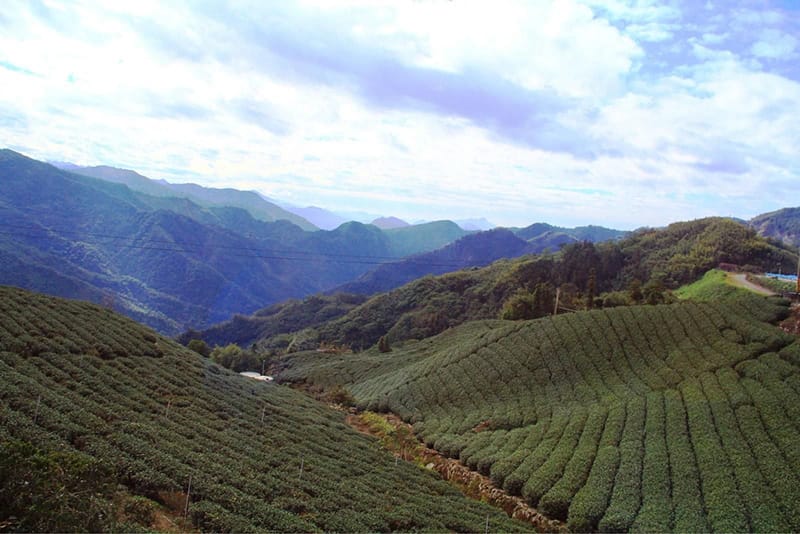
Guangdong
Guangdong Oolong teas are primary from the Chaoshan regions. Here is also the Gongfu Tea Ceremony birthplace; making Oolong tea in a Gongfu Tea way can improve the fragrance. Chaoshan Oolongs are famous for their pungent aroma. They are also classified according to the aroma types; one of them got a funny name – Duck Shit Aroma.
Other Regions
Japan, Korea, India, and Malaysia also producing Oolong teas, but the yield is farther from China.
Oolong Tea Varieties
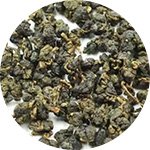
Dong Ding Oolong
Dong Ding Oolong tea is the most famous tea in Taiwan, belongs to high mountain tea, most from the plantations above 1000 meters altitude. It is more focused on roasting during processing, with a strong roasted flavor. More than it, some tea lovers will re-baked the leaves during storage to remove the damp and get a deeper taste.
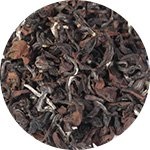
Dongfang Meiren
Dongfang Meiren tea has various names: Oriental Beauty, Five Colors tea, Pengfeng (bragging) Tea, White-tip Oolong. Its cultivation way is very special. It doesn’t use pesticides because it needs a little bug called Empoasca to bite the leaves, creating a unique flavor. Besides, Dongfang Meiren tea fermentation degree typically high to 70%, close to black tea.
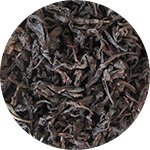
Da Hong Pao
Da Hong Pao tea is the represent of Wuyi Rock tea, ever was the most expensive tea in the world. In an auction in 2002, 20g Da Hong Pao fetched about 28 thousand dollars, which was expensive than the gold price at that time. When President Nixon visited China, Chairman Mao gave him 200g Da Hong Pao tea as a gift; it gave the tea a higher social status. Nowadays, authentic Da Hong Pao is rare; the ones sold on the market almost blended tea. And the Wuyi local gov also allows all the rock teas origin there to take Da Hong Pao as the brand.
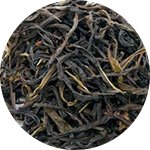
Phoenix Dan Cong
Phoenix Dan Cong tea originated in the place the Gongfu Tea Ceremony birthed – Chaozhou China. Phoenix refers to a high-quality Oolong tea tree – Phoenix Narcissus, and Dan Cong means the best single of them. Phoenix Dan Cong tea is regarded as “the perfume in teas.” Senior tea master can make the leaves develop various fragrances by control the temperature during processing. The common aroma types are over ten; one of them is the funny – duck shit aroma.
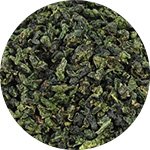
Tieguanyin
Tieguanyin originates in Anxi, Fujian, which is the most popular Oolong. It may be the first Oolong that many people first tried. The Qing-flavor type Tieguanyin sends out a fresh orchid fragrance, and the Strong-flavor type got a higher fermented degree and a more authentic flavor. Except for Anxi, Mu Zha of Taiwan also produces Tieguanyin tea, which is as good as the Anxi ones, and famous for its roasted flavor.
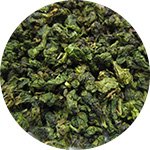
Huangjin Gui
Huangjin Gui is one of the Anxi great tea trees. It is famous for its full osmanthus aroma but the light taste. Because most capacity is occupied by Tieguanyin, Huangjin Gui tea’s yield is low. Most of the time, it is one ingredient of Tieguanyin blended tea. In Southeast Asia, Huangjin Gui tea is still loved by many people.
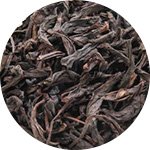
Tieluohan
One of the Wuyi 4 Great Ming Cong. Tieluohan is regarded as the earliest Wuyi Rock tea, much older than Da Hong Pao. Just like its name (Iron Arhat), Tieluohan got a strengthful TCM scent like Angelica, and the unique rock tea feature “Yan Yun.” After the infusion slide down your throat, your mouth will be filled with floral, fruity, TCM aroma, and slightly sweet.
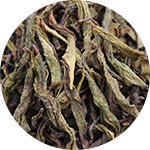
Bai Jiguan
One of the Wuyi 4 Great Ming Cong. Bai Jiguan is the most special one in Wuyi Rock tea. Its leaves are from the tea tree with Leaf Albinism, which shows yellow. Unlike the Tieluohan strengthful flavor, Bai Jiguan tastes like a tender girl; it’s a flavor similar to the herbs like Houttuynia and Honeysuckle. Besides, Bai Jiguan is also regarded as “Taoist Tea.” It is said a leader of Taoism ever took it as a daily beverage and finally became an immortal.
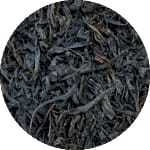
Narcissus (Shui Xian)
Narcissus (also called Shui Xian tea) is a famous Oolong and also a kind of Camellia Sinensis species. It is widely cultivated and processed in Fujian and Guangdong. As one of the Rock Tea, Wuyi Narcissus Oolong has a charming “rock taste.” But to Guangdong Narcissus, it is more focused on the aroma.

Rougui
Rougui is another iconic Wuyi Rock Tea. Besides the special rock taste, it also has a charming, pungent, cinnamon-like flavor. Rougui tea is graded by the tea planting grounds. Due to each garden’s name containing an animal name, tea fans love to call the teas “meat.” The “beef” Rougui from Niu Lan Keng tea ground is honored the best, and it’s very costly.
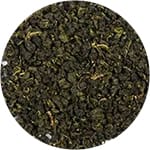
Milky Oolong
People typically call the Jinxuan Oolong tea from Taiwan Milky Oolong. That’s because this tea has a natural and unique milk flavor, attracting young tea lovers much. Unfortunately, some dishonest tea merchants often cheat people by adding artificial flavors to the common leaves. You should pay more attention while buying.
Oolong Tea Nutrition Fact
Tea Polyphenol
Oolong tea does not contain as much tea polyphenol as green tea and other mildly-fermented teas; most of them are transformed into other nutrients during fermentation. Catechins and tea pigments are the primary polyphenols in Oolong tea. Due to the different fermentation degrees during processing from one origin to another, the tea polyphenol retains in Oolong tea also different.
Related Reading: Healthy Tea Diet: What Are Tea Polyphenols & 8 Excellent Benefits.
Tea Polysaccharide
Tea polysaccharide is a compound nutrient fact in Oolong tea, which is formed in the fermentation process. Although black tea is fermented tea too, due to the high fermentation(black tea is completed-fermentation tea), the tea polysaccharide content in black tea is much lower than Oolong tea.
In addition to sweetening Oolong tea, tea polysaccharides are an excellent nutrient fact that helps lower blood lipids and blood sugar.
Amino Acids
During Oolong tea’s fermentation, most of the amino acids in fresh tea leaves switched to other substances. A part of amino acid is transformed into the aromatic material, which makes Oolong tea a strong scent; another part is preserved, which can be soluble in water and forms the fresh flavor of Oolong tea.
Caffeine
Oolong tea is a kind of true tea, and it contents caffeine. The caffeine it contains is lower than green tea because some caffeine is lost during fermentation and baking. Caffeine has the function of refreshing the brain, and digestion is a common nutrient of tea drinks. But take too much caffeine may cause insomnia.
Related Reading: Worry About The Caffeine In Tea? 4 Tips For You!
Minerals
Oolong tea is rich in minerals such as K, Ca, Mg, Fe, Mn, Cu, and F. These essential trace elements cannot be produced or synthesized by the human body itself. Moderate intake helps to maintain the human body’s performance.
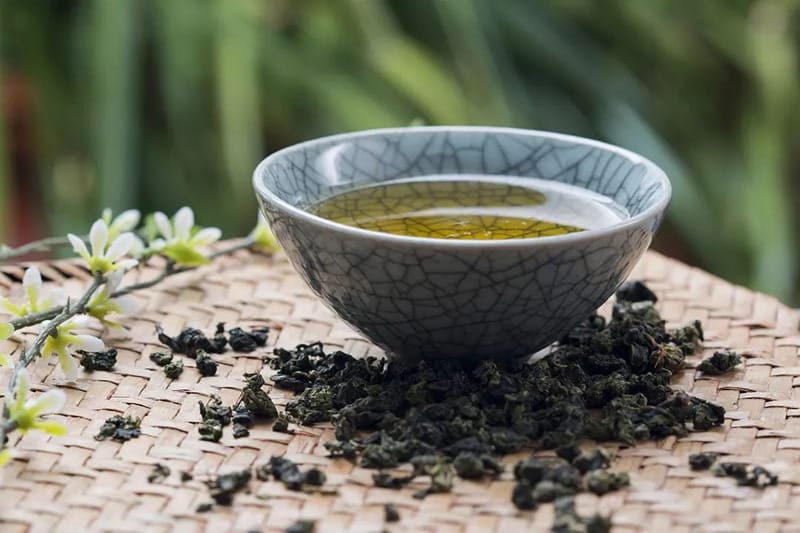
Oolong Tea Benefits
Hypolipidemic
Oolong tea is rich in catechins, a polyphenolic substance that has antioxidant and hypolipidemic effects.
The studies suggest that after the subjects consume Oolong tea for a while, the level of blood lipids in the body decreased significantly, and the mild fatty liver returned to the normal liver state. And Oolong tea is more effective at reducing triglycerides than green or black tea.
Manage Diabetes
The tea polysaccharide in Oolong tea has the effect of stimulating insulin secretion. The study suggested that glucose and fructosamine concentration in diabetic patients’ bodies decreased significantly after having Oolong tea. Combined with Oolong tea can balance plasma glucose more effectively than drugs taken alone.
Besides, type 2 diabetes is mostly associated with obesity. Oolong tea can help with weight loss, effectively manage type 2 diabetes, and reduce the risk of suffering diabetes.
Weight Loss
Help weight loss is the effect that Oolong tea gets concerned with most. Lots of studies have confirmed that Oolong tea has a significant impact on decomposing fat. It mainly ascribes to the synergistic effect of tea polysaccharides, tea polyphenols, and caffeine in Oolong tea.
Tea polyphenols and tea polysaccharides can effectively inhibit fat accumulation inside the body and accelerate the combustion of fat to provide energy to the human body.
At the same time, Oolong tea can also help promote metabolism, reduce the accumulation of metabolites in the body, also play a positive role in losing weight.
Worth knowing, in the comparative study, the researcher found that compares to the non-fermented green tea, the effect on losing weight that fermented Oolong tea is better.

Potential Anti-Cancer
The tea polyphenols in Oolong tea are a natural antioxidant. It can induce cell apoptosis, inhibit cell proliferation and the form of tumor vessels. It also has an anti-inflammatory feature, reducing inflammation in the body and the risk of cancer.
Researchers have experimented with Oolong tea extracts, which have shown great potential in preventing breast cancer.
Dermatitis Treatment
Oolong tea is deemed to have a therapeutic effect on dermatitis. In one study, 118 patients with Recalcitrant Atopic Dermatitis (AD) were tested, and 74 (63%) of them improved significantly after having Oolong tea for 1 month.
The researchers speculate that the polyphenols’ antiallergic properties in Oolong tea took a powerful effect on the treatment.
Although there is not enough evidence to support Oolong tea as a treatment for Recalcitrant Atopic Dermatitis, it generally helps in mild cases.
Potential Side Effects
Insomnia
Oolong tea naturally contains caffeine. It can excite the nerves to reach a refreshing brain effect. But if you intake caffeine too much, it will cause a headache. Having Oolong tea before bed will cause insomnia easily.
Medicine Interactions
Oolong tea contains tea tannin, which is easy to interacts with some medicine and makes it fail. People who during drugs are not recommended to have Oolong tea unless asking their doctor for permission.
How To Store Oolong Tea Properly
On the problem of Oolong tea storage, people always argue if it is suitable for aging.
Some people thought, as long as the Oolong tea got a deep enough roasting degree, it can be long-term. It can develop a more excellent flavor like white tea by the internal substances transform during aging under a proper storage way. And some tea lovers will rebake the Oolong tea every once in a while during storage to get a deeper roasted flavor.
People with an opposing view thought that Oolong tea’s main charming is the aroma. A long time of storing will make the aroma lose and let the tea become valueless. Besides, Oolong tea belongs to partially-fermented tea, and it’s tough to aging a long time; the ordinary Oolong also has no need to do it. So they thought it’s reasonable to finish consuming Oolong ASAP.
Of course, without talking about the long time aging, Oolong tea still able to be store for half or two years in a proper way. During the storage, the following requires to the environment:
- Dark
- Low temperature (under 20℃)
- Airtight
- Dry
Now, most of the Oolong tea products on the market are with small individual sealed packages. All you need to do is put them in an airtightness iron can, then store them in a cool and dry place. To the low-fermented Oolong, store it in a fridge will be better.
To the Oolong loose-leaf, you need to pack them well with rice paper first, then store them in a clay can; it will be better to wrap a rice paper on its surface to improve the moisture resistance. Please pay attention, never store the loose leaf in the fridge; their dry bodies easily absorb the water in the air and the smell from other food.
Related Reading: Choose the best tea storage container for loose leaf tea.
REFERENCE
A Trial of Oolong Tea in the Management of Recalcitrant Atopic Dermatitis
Antihyperglycemic Effect of Oolong Tea in Type 2 Diabetes
Oolong tea polysaccharide and polyphenols prevent obesity development in Sprague–Dawley rats
A Review on the Weight-Loss Effects of Oxidized Tea Polyphenols